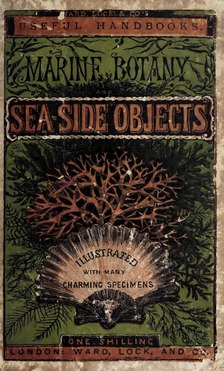
| This article's factual accuracy may be compromised due to out-of-date information. The reason given is: Classifications discussed are very out of date. Please help update this article to reflect recent events or newly available information. (October 2024) |
| This section may contain material not related to the topic of the article. Please help improve this section or discuss this issue on the talk page. (October 2024) (Learn how and when to remove this message) |
| Marine habitats |
|---|
| Coastal habitats |
| Ocean surface |
| Open ocean |
| Sea floor |
Marine botany is the study of flowering vascular plant species and marine algae that live in shallow seawater of the open ocean and the littoral zone, along shorelines of the intertidal zone, coastal wetlands, and low-salinity brackish water of estuaries.
It is a branch of marine biology and botany.
Marine Plant Classifications
There are five kingdoms that present-day classifications group organisms into: the Monera, Protist, Plantae, Fungi, and Animalia.
The Monera
Less than 2,000 species of bacteria occur in the marine environment out of the 100,000 species. Although this group of species is small, they play a tremendous role in energy transfer, mineral cycles, and organic turnover. The monera differs from the four other kingdoms as "members of the Monera have a prokaryotic cytology in which the cells lack membrane-bound organelles such as chloroplasts, mitochondria, nuclei, and complex flagella."
The bacteria can be divided into two major subkingdoms: Eubacteria and Archaebacteria.
Eubacteria
Eubacteria include the only bacteria that contain chlorophyll a. Not only that, but Eubacteria are placed in the divisions of Cyanobacteria and Prochlorophyta.
Characteristics of Eubacteria:
- They do not have any membrane-bound organelles.
- Most are enclosed by a cellular wall.
Archaebacteria
Archaebacteria are a type of single-cell organism and have a number of characteristics not seen in more "modern" cell types. These characteristics include:
- Unique cell membrane chemistry
- Unique gene transcription
- Capable of methanogenesis
- Differences in ribosomal RNA
Types of Archaebacteria:
- Thermoproteota: Extremely heat-tolerant
- "Euryarchaeota": Able to survive in very salty habitats
- "Korarchaeota": The oldest lineage of archaebacteria
Archaebacteria vs. Eubacteria
While both are prokaryotic, these organisms exist in different biological domains because of how genetically different they are. Some believe archaebacteria are some of the oldest forms of life on Earth while eubacteria arose later in evolutionary history. As eubacteria are found in almost all environments, archaebacteria have been pushed to only the most extreme environments. These extreme environments include: high salinity lakes, thermal hot springs, and deep within the Earth's crust. Other differences include:
- While most eubacteria are susceptible to antibiotics, archaebacteria are not.
- Archaebacteria typically do not infect humans.
- While eubacteria have the ability to form spores to survive adverse conditions, archaebacteria do not have this ability.
Kingdom Protist
The Protist kingdom contains species that have been categorized due to the simplicity of their structure and being unicellular. These include protozoa, algae and slime molds. In marine ecosystems, macroalgae and microalgae make up a large portion of the photosynthetic organisms found. The algae can be then further categorized based on these characteristics:
- Storage products
- Photosynthetic pigments
- Chloroplast structure
- Inclusions of the cell
- Cell wall structure
- Flagella structure
- Cell division
- Life history
The algae in the Protist kingdom can be placed into three different categories of macroalgae/seaweeds—phaeophyta, rhodophyta or chlorophyta. The microalgae in these marine environments can be categorized into four varieties—pyrrhophyta, chrysophyta, euglenophyta or cryptophyta.
Examples of the types of organisms found in the Protist Kingdom are red, green and brown algae.
Kingdom Plantae
The Plantae Kingdoms consists of angiosperms-plants that produce seeds or flower as a part of their reproductive system. About 0.085% of the 300,000 Angiosperms believed to exist can be found in marine like environments.
Some examples of what plants in this kingdom exist are mosses, ferns, seagrasses, mangroves, and salt marsh plants—the last three being the three major communities of angiosperms in marine waters.
Seagrasses are recognized as some of the most important member to marine communities. It is the only true submerged angiosperm and can help determine the state of an ecosystem. Seagrass helps identify the conditions of an ecosystem, as the presence of this plant aids the environment by: Stabilizing the water's bottom, providing shelter and food for animals, and maintaining water quality.
Marine ecology
Marine ecology and marine botany include:
See also
- Aquatic plants
- Aquatic ecology
- "Aquatic Botany" — scientific journal
- Phycology — study of algae
- Index: Marine botany
- Marine primary production
References
- ^ Dawes, Clinton J. (1998-02-27). Marine Botany. John Wiley & Sons. ISBN 978-0-471-19208-4.
- ^ Editors, B. D. (2016-11-25). "Eubacteria". Biology Dictionary. Retrieved 2020-11-23.
{{cite web}}:|last=has generic name (help) - ^ Editors, B. D. (2016-11-05). "Archaebacteria". Biology Dictionary. Retrieved 2020-11-23.
{{cite web}}:|last=has generic name (help) - Editors, B. D. (2016-10-30). "Angiosperm". Biology Dictionary. Retrieved 2020-11-23.
{{cite web}}:|last=has generic name (help) - "Importance of Seagrass". Florida Fish And Wildlife Conservation Commission. Retrieved 2020-12-08.